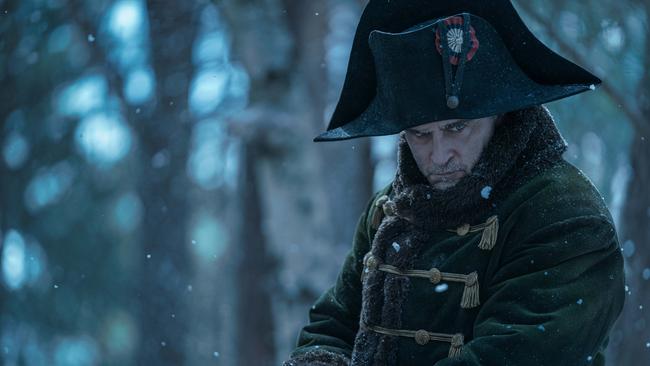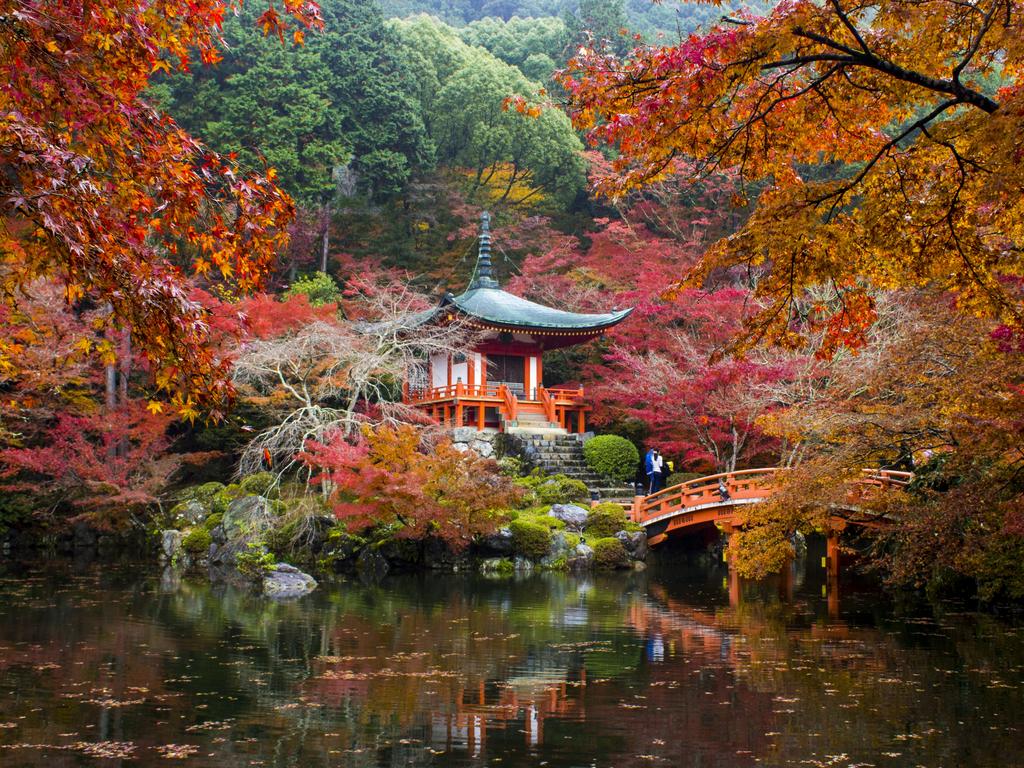Into the world of Napoleon … and Josephine
With Ridley Scott’s biopic on Bonaparte opening next week, it’s the perfect time to revisit the infamous general’s stomping grounds.

‘We are born, we live, we die amidst marvels,” said French general Napoleon Bonaparte (1769-1821), whose trajectory from young Corsican soldier to all-powerful emperor was so extraordinary he remains a formidable figure two centuries later.
Was he the brilliant military man who consolidated the political and social legacies of the French Revolution or an insatiably ambitious dictator? They say each generation creates their own Napoleon, and this year we will have ours.
Director Ridley Scott brings the ultimate military alpha male to Australian cinema screens this month, with Joaquin Phoenix portraying the French leader as a cool-headed strategist who conquered everything.
As Hollywood’s bright lights illuminate the Napoleonic era’s influence on world events and contemporary French life and law, and our attention turns once more to the Empire aesthetic of the early 1800s, inspired travellers can step inside Napoleon’s world.
The destinations that feature in Napoleon’s conquests and defeats are fascinating; we can also visit the spaces where his voice once echoed and his dreams of empire vanished.
Get up close and personal with an almighty conqueror who ended his days banished from France, the country he once ruled.


Ajaccio, Corsica
Nothing humanises a towering figure like birth and death. Napoleon was born in the stunning, sleepy port of Ajaccio, capital of the rugged French Mediterranean island Corsica. The cobblestoned streets of the old town are largely unchanged from Napoleon’s early years. A few minute’s walk from the promenade is a long stretch of palm-fringed beach with calm waters ideal for swimming.
A stroll among the town’s picturesque mansions and earth-coloured villas brings Napoleon’s timeline out of the history books and into real life. Maison Bonaparte, the townhouse where he was born, on the corner of Rue Saint-Charles, is now a museum. The collection of drawing rooms, boudoirs and alcoves offers a frozen-in-amber perspective of 18th-century domestic life, with highly decorative and compartmentalised spaces. The trapdoor Napoleon apparently used as an exit on his last visit to the island in 1799 is still there.

He was baptised in the nearby Baroque/Mannerist cathedral; its splendid interior of arched ceilings studded with marble carvings, and Renaissance art (including a Delacroix), is a dazzling, cooling cavern away from the bright Mediterranean sun. It’s also worth a trip to the portside market to try the island’s renowned olives, honey, charcuterie and cakes.
In the heights of Ajaccio, visitors can wander the old-growth olive groves of the Milelli estate, the Bonaparte family’s 12ha holiday home with rambling Mediterranean garden where Napoleon once played. The destiny that awaited him beyond boyhood is exemplified by the grandeur of local monuments. A statue depicting the leader in his trademark military bicorn hat, overlooks the town from an elevated garden, accessible via tour train or a 20-minute uphill neighbourhood walk. An equestrian statue in the Place de Gaulle portrays Napoleon victorious on horseback, crowned with a laurel wreath to evoke Roman emperor Caesar; he’s holding a globe – the world in his hands.

Musee de l’Armee, Paris
The golden dome of the Hotel National des Invalides is a Paris landmark; a triumphant example of French Baroque architecture from the era of King Louis XIV. It now houses a museum complex that includes the Musee de l’Armee, showcasing the history and culture of war.
From the time Napoleon joined the French army to become an artillery officer, his genius as a military leader was evident. This is the place to trace his campaigns and core strategies, such as the pursuit of speed on the battlefield. It is fascinating to see how technologies and tactics were developed in his imperial campaigns in Germany, Prussia, Austria, Spain, Russia and France, yet 500,000 war-related art works and artefacts, including weapons, artillery and ceremonial garments, also bring Napoleon’s infantry and cavalry to life. Thrillingly, this includes uniforms that Napoleon wore himself. The statesman’s suitably grandiose tomb is housed in Chapelle Saint-Jerome, within the Invalides, where his remains were transferred 20 years after his death in exile.

Chateau de Malmaison, France
Although Napoleon lived and breathed army life after he joined military school at 15, he is also famous for the depth of his passion for Josephine Tascher de La Pagerie, the Creole widow whose husband was guillotined during the revolution’s Reign of Terror. Like King Henry the Eighth, Napoleon left behind letters professing his ardent love and desire (“The charms of the incomparable Josephine … rob me of reason, and inflame my blood”).
The year after Napoleon led the army into Egypt to defend French trade interests in 1798, the newly married couple found domestic bliss at the idyllic Malmaison, a French chateau about 15km from the heart of Paris and near the Seine. What was a two-hour horse and carriage ride out of Paris for Napoleon and Josephine is now a swift RER or metro trip to La Defense Grande Arche station for visitors (followed by a short Uber or bus ride). Although it is now a museum, Malmaison still immerses visitors in the couple’s private world.


The elegant manor house is a chance to witness the changing ideals of French refinement during the First Empire. Masculine boldness sweeps away the feminine fripperies and pastels of French royalty to be replaced by echoes of antiquity: Doric columns, Palladian motifs and the pomp of Napoleon’s bed, flanked by golden eagles. Rome and Pompeii-inspired art becomes the backdrop to high society, as women start to wear the classical silhouette of Grecian-inspired dresses (also familiar to us from author Jane Austen’s era). Travellers can wander through the rooms where the new elite frolicked at balls, and played backgammon and billiards.
Napoleon’s impressive Salle de Conseil is hung with striped twill, conjuring the look of a commander’s tent during war time. Being in the room where he created the Code Napoleon, still the civil-law framework of France, is captivating. Malmaison is a superb example of how high fashion mirrored the era’s military conflicts, with martial decor, pennant draperies and tented beds recalling life on the battlefields. Yet the portraits and possessions of the couple throughout the house, including in the music salon and library (where Napoleon inscribed books with his initials), reek of domestic life.
Josephine created a magnificent garden with roses from her beloved native Martinique, along with pineapples and exotic animals such as kangaroos, emus, zebras and ostriches. The critters are long gone but guests can still wander around a stunning sea of blooms. Among the many objects that humanise Napoleon are those that mythologise him, too; visitors can see the famous Jacques-Louis David portrait, Napoleon Crossing the Alps, up close. Rearing on his war horse, our late host is every inch the dashing war hero.

Arc de Triomphe
After Napoleon and Josephine were crowned emperor and empress in 1804, the military triumphs of the French armies inspired the leader to commission the Arc de Triomphe in Paris in their honour. Napoleon even laid the first stone himself, in 1806. The Roman-style, recessed-grid design and roll call of generals couldn’t be more First Empire. The arch has since evolved to become such a symbol of French identity that each Bastille Day the annual military parade marking the revolution kicks off here. July is also an exciting time to visit the arch, when the world champions of the Tour de France cycle into the Place Charles de Gaulle to the finish line.

Elba, Italy
Napoleon made the same mistake that Adolf Hitler repeated centuries later and tried to invade Russia. This move ushered in his defeat and eventual abdication as the royal Bourbons were restored to power. The former emperor was allowed to rule his new fiefdom of Elba in 1814, a 223sq km island that is now protected by the national park of the Tuscany Archipelago. Today’s visitors can arrive by ferry, which crosses from six ports on the Italian mainland and Corsica. It is possible to visit the villa that was Napoleon’s home, originally built by the Medicis, in Portoferraio, one of a string of historical hamlets on the island. The books that he brought with him, as well as the imperial-style furniture and balloon chandeliers, help travellers imagine the defrocked emperor’s stay here at his court in miniature, far from the lofty status of his former seats of power, the Tuileries and Chateau de Fontainebleau.
Elba is an idyllic Mediterranean seaside getaway, with its Italian-style beach clubs and wildly beautiful swimming spots such as the white pebble crescent of Sansone or Capo Sant’Andrea. Famous snorkelling sites, such as Formiche della Zanca, are the spectacular habitat of yellow seahorses and bright pink coral. Local menus feature an abundance of seafood, with traditional dishes such as boiled octopus, spaghetti with spider crab, and cacciucco, a fish soup that traditionally repurposed the last of the day’s catch of octopus, cuttlefish and scorpion-fish.
Napoleon’s true nature could not be suppressed for long. After 300 days of rule, he used his small force of 650 Imperial Guards to escape the island, appealing to each regiment he encountered – and once commanded – to avoid arrest. He won them over and eventually regained control of France. After his defeat at the infamous Battle of Waterloo, the British were more vigilant and exiled him to St Helena, 1900km off the west coast of Africa, to end his days.

Napoleon III Apartments at Musee du Louvre, Paris
Apart from administrative reforms, Napoleon left another legacy; his bloodline returned to power. His nephew, the emperor Napoleon III, not only became France’s last monarch, but its first president (1848-1852). Like his uncle, the emperor brought about great reforms, enacting pensions for civil servants and authorising the right to strike in 1864.
Travellers are lucky enough to be able to see an intact, preserved historical space that reflects this Second Empire at the Minister of State’s apartments at the Louvre museum. The authentic Napoleon III decor shows us the grandeur and opulence of the new nobility’s world, where ministers and courtiers fraternised, did government business, and enjoyed live music. Many of the museum’s trove of archeological treasures were found on the original Napoleon’s campaigns in Greece, Rome, Pompeii and Egypt. These antiquities inspired a wave of 19th-century Egyptomania and neoclassicism in furniture, art, and ornamentation. Happily, we can switch off from the modern city, and re-experience the same surroundings as these generations of empire, who changed Europe forever.
Napoleon opens in Australian cinemas on November 23.





To join the conversation, please log in. Don't have an account? Register
Join the conversation, you are commenting as Logout